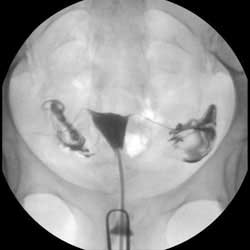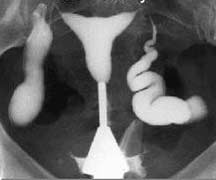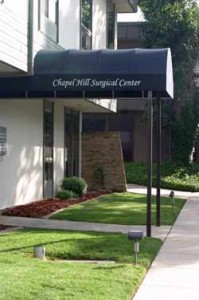 Diagnosing tubal blockage when you have had a tubal ligation procedure is easy; however, diagnosing a blocked fallopian tube from other causes is more involved.
Diagnosing tubal blockage when you have had a tubal ligation procedure is easy; however, diagnosing a blocked fallopian tube from other causes is more involved.
After tubal blockage is diagnosed , the area of blockage can often be corrected with specialized tubal surgery.
The previous blog article, Reasons For A Blocked Fallopian Tube, discussed how tubal scar tissue can block fallopian tubes and cause infertility.
This article reviews both the diagnosis and treatment of blocked tubes.
Are My Tubes Blocked?
This question should only be asked if pregnancy has either never happened or if pregnancy has not happened after a year of actively trying.
If pregnancy has not happened after a year of active effort then the three tests which have to be considered are a semen analysis, ovulation testing, and a hysterosalpingogram x-ray (HSG).
Ovulation test can be obtained from the drug store and will let a woman know if she is ovulating regularly (releasing an egg every month). A semen test must be ordered by a medical professional and should be performed at a qualified medical laboratory. If egg release is occurring every month and the semen analysis is normal then tubal blockage may be the cause for difficulty in conceiving.
Test To Diagnose Tubal Blockage
Blocked tubes can be diagnosed several ways: direct observation in the operating room or more commonly by a HSG x-ray.
A HSG x-ray is done by a radiologist. Dye is placed into the cavity of the uterus and x-ray pictures are taken as the dye travels into and out of the fallopian tube. If dye does not pass completely through the tube this can be evidence of tubal blockage.
Proximal Tube Blockage
If the dye stops at the very start of the tube then this can be evidence of proximal tube blockage.
The most common reason for proximal tubal closure in a woman who has not had a tubal ligation is from a poorly understood condition called salpingitis isthmica nodosa (SIN). SIN occurs when the tubes develop multiple little bulges inside the tube. This condition can increase the risk of ectopic pregnancy and can cause complete blockage of the part of the tube as it enters the uterus. This tubal disease has a very characteristic pattern on a HSG x-ray.
Hydrosalpinx: Distal Tubal Blockage
 Tubal hydrosalpinx occurs when the end of the tube is closed. If the dye travels to the end of the tube but cannot pass the blockage on the end of the tube, then the tubes will have a swollen appearance on the HSG x-ray. This swollen tube is called a hydrosalpinx.
Tubal hydrosalpinx occurs when the end of the tube is closed. If the dye travels to the end of the tube but cannot pass the blockage on the end of the tube, then the tubes will have a swollen appearance on the HSG x-ray. This swollen tube is called a hydrosalpinx.
A hydrosalpinx can result from any condition that causes blockage at the end of the tube. A previous infection is often the number one cause of hydrosalpinx.
Treatments For Tubal Blockage
Proximal tubal blockage can be repaired with an advanced technique called tubouterine implantation. This procedure removes the diseased section of the tube and the healthy tube is then re-inserted through the muscle of the uterus and into the uterine cavity.
Pregnancy rates after tubouterine implantation can be as high as 50%.
Treatments For Hydrosalpinx
A tubal hydrosalpinx can be corrected by removing the tubal blockage and opening the end of the tube to create a new opening. This procedure is called an ampullary salpingostomy. Pregnancy rates after ampullary salpingostomy range from 15-50% and depend on the length and health of the remaining fallopian tube.
Treatments For Blocked Tubes
 At A Personal Choice Dr. Berger and Dr. Monteith can repair blocked tubes utilizing the above techniques.
At A Personal Choice Dr. Berger and Dr. Monteith can repair blocked tubes utilizing the above techniques.
These procedures are performed as out-patient surgeries and can provide patients with the ability to become pregnant naturally.
These procedures can correct blocked tubes and can provide an alternative to in-vitro fertilization (IVF).
If readers are interested in obtaining more information they are invited to call (919) 968-4656 to speak with a nurse. Women with tubal blockage are encouraged to send their medical records, surgical reports, and HSG images for the tubal repair specialists to review. If they are able to offer you a chance at pregnancy then they will most certainly let you know after your records have been reviewed.










